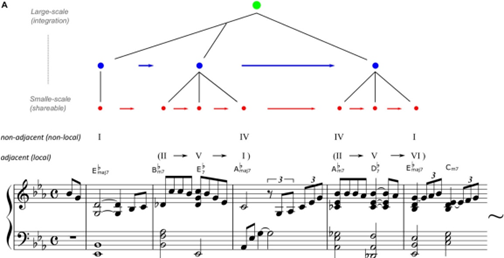Exploring cognitive individuality and the underlying creativity in statistical learning and phase entrainment
DOI:
https://doi.org/10.17179/excli2023-6135Keywords:
phase entrainment, Bayesian, chunking, hierarchy, music, rhythmAbstract
Statistical learning starts at an early age and is intimately linked to brain development and the emergence of individuality. Through such a long period of statistical learning, the brain updates and constructs statistical models, with the model's individuality changing based on the type and degree of stimulation received. However, the detailed mechanisms underlying this process are unknown. This paper argues three main points of statistical learning, including 1) cognitive individuality based on "reliability" of prediction, 2) the construction of information “hierarchy” through chunking, and 3) the acquisition of “1-3Hz rhythm” that is essential for early language and music learning. We developed a Hierarchical Bayesian Statistical Learning (HBSL) model that takes into account both reliability and hierarchy, mimicking the statistical learning processes of the brain. Using this model, we conducted a simulation experiment to visualize the temporal dynamics of perception and production processes through statistical learning. By modulating the sensitivity to sound stimuli, we simulated three cognitive models with different reliability on bottom-up sensory stimuli relative to top-down prior prediction: hypo-sensitive, normal-sensitive, and hyper-sensitive models. We suggested that statistical learning plays a crucial role in the acquisition of 1-3 Hz rhythm. Moreover, a hyper-sensitive model quickly learned the sensory statistics but became fixated on their internal model, making it difficult to generate new information, whereas a hypo-sensitive model has lower learning efficiency but may be more likely to generate new information. Various individual characteristics may not necessarily confer an overall advantage over others, as there may be a trade-off between learning efficiency and the ease of generating new information. This study has the potential to shed light on the heterogeneous nature of statistical learning, as well as the paradoxical phenomenon in which individuals with certain cognitive traits that impede specific types of perceptual abilities exhibit superior performance in creative contexts.

Downloads
Published
How to Cite
License
Copyright (c) 2023 Tatsuya Daikoku, Kevin Kamermans, Maiko Minatoya

This work is licensed under a Creative Commons Attribution 4.0 International License.
Authors who publish in this journal agree to the following terms:
- The authors keep the copyright and grant the journal the right of first publication under the terms of the Creative Commons Attribution license, CC BY 4.0. This licencse permits unrestricted use, distribution and reproduction in any medium, provided that the original work is properly cited.
- The use of general descriptive names, trade names, trademarks, and so forth in this publication, even if not specifically identified, does not imply that these names are not protected by the relevant laws and regulations.
- Because the advice and information in this journal are believed to be true and accurate at the time of publication, neither the authors, the editors, nor the publisher accept any legal responsibility for any errors or omissions presented in the publication. The publisher makes no guarantee, express or implied, with respect to the material contained herein.
- The authors can enter into additional contracts for the non-exclusive distribution of the journal's published version by citing the initial publication in this journal (e.g. publishing in an institutional repository or in a book).





